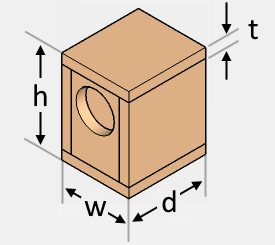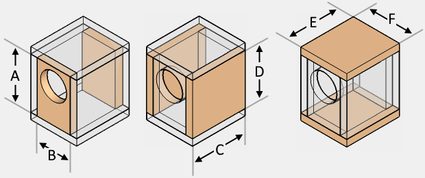Speaker Box Calculator
This speaker box calculator or subwoofer box calculator will help you determine the boards' measurements to cut when building a speaker box of your own. We can also treat it as a speaker box volume calculator as it can also help you find your speaker box's internal volume depending on its dimensions, board thickness, speaker driver displacement, and tube port (if needed). As a bonus, we have also included in this tool a speaker driver displacement calculator for your convenience.
In this calculator, you will also learn some guidelines on how to build a speaker box and how to calculate speaker box volume yourself (or how to find the volume of a box in general). At the end of this text, don't miss our sample calculation for a 12-inch speaker box. Keep on reading to start learning!
Building a speaker box
Building your very own speaker or loudspeaker, whether it be a full-range speaker, a woofer, a mid-range speaker, or a tweeter, is a fun experience. It challenges our creativity, most especially in terms of woodworking, electronics, and our understanding of sound. Expand your knowledge about sound by visiting and reading through our dB calculator.
Building a speaker box means we have full control over its design and size, not just over the speaker driver you want to use, but also over the sound quality.
However, in this basic speaker box building guide, we only focus on the speaker box itself, the volume displaced by the speaker driver, and the speaker tube port (if ever we need it). Keep on reading to learn more.
How to build a speaker box?
Building a speaker box is like building any kind of wooden box, except that it doesn't have any moving parts like lids or covers. We cut boards of wood or fiberboard to size and assemble them into a closed box with proper sealing, using enough glue or caulking on the joints.
- The first step in building a speaker box is to decide on its design and size. If you are keen on clean audio and deep bass, your best choice is a ported speaker box. On the other hand, if you are not much concerned by the bass, a sealed speaker box should be your go-to option. Here is a side-by-side comparison of the sealed (left) and ported (right) speaker boxes:
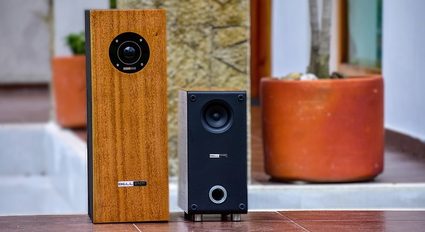
- Once you've decided on the size and design to build, the next step is to determine your speaker box's board panels' measurements. We can calculate each panel's dimensions depending on the speaker box's dimensions and the board's thickness. From the sample illustration below, we can see that the front panel's width is smaller than the speaker box's width by twice the board's thickness. This also holds with the side panel's height.
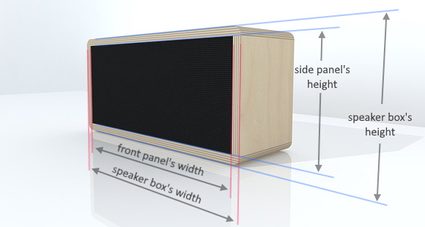
On the other hand, we can also see in the example above that the side panel's width is the same as the speaker box's depth. The measurements of the panels depend on the design of your speaker box. Our calculator offers six designs for you to choose from, as you can see in the assembly case field of our calculator.
- After cutting your boards, it's now a matter of assembling the panels to form the speaker box. We can butt-joint the board pieces together or miter them for a seamless look. Check out our miter angle calculator if you want to implement miter joints on your speaker box. However, butt joints are stronger and easier to do than miter joints. Butt joints are also easier to seal and are still aesthetically pleasing.
Now that you know how to build a speaker box, let us now learn how to use our calculator to easily find your board panels' dimensions.
How to use our speaker box calculator?
Our speaker box tool is packed with a few features that will help you get started in building your speaker box. Here are the steps on how to use our speaker box calculator:
- Choose the assembly case you wish to make. At first glance, each assembly might seem to be identical. However, during the actual assembly, you might consider recessing a face or two to give your speaker box an added character. You can choose case 1 or case 2 to have the front side recessed, as shown below, or case 3 or 4 to recess the side panels. It's your choice.
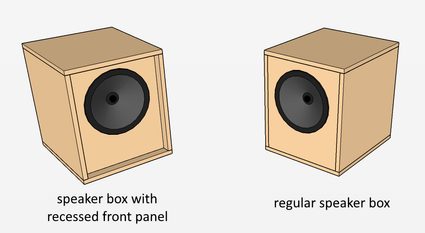
-
Once you've chosen the assembly case, the next step is to enter your speaker box outside dimensions. That is its width, height, and depth.
-
The next step is to input the thickness of the board you want to use. Speaker boxes are typically made of
3/4-inchto1-inch(20-mmto25-mm) thick boards. Upon filling in this field, theinternal volume of the boxfield will already show a calculated result. After inputting this, you will find a board-cutting guide at the bottom of our calculator. -
If you decide to install a speaker tube port, select
Yesin the Are you making a ported speaker box? field. Doing so will reveal theport diameterandport lengthfields for you to fill in. This will update the value of the internal volume of the box accordingly. You can also input a particular port volume for other port shapes, provided you know its value. Having this feature also makes this tool a subwoofer box calculator. -
If you already have a speaker driver, you can select
Yesfor this next field to display our speaker driver displacement calculator. Input the required values for the cone diameter, mounting depth, magnet diameter, and magnet depth to calculate a speaker driver's displacement and automatically update the box's internal volume.
🙋 Don't forget to use our crossover calculator to complete your speaker box assembly.
How to calculate speaker box volume?
To estimate the speaker box volume, we need to determine the box's internal dimensions and multiply them together. Typically, the board thickness is uniform throughout the speaker box's body. With this concept, we can formulate the speaker box volume equation as follows:
where the variables used are:
- – Speaker box's internal volume without the speaker driver and port;
- – Width of the speaker box;
- – Board thickness;
- – Height of the speaker box; and
- – Depth of the speaker box.
However, the internal volume of the speaker box decreases when we introduce our speaker driver and ports. In this calculator, we approximate the speaker driver's volume displacement by evaluating the cone formed by its cone casing and the cylindrical volume taken up by the speaker magnet.
The total internal volume of the speaker box would then be:
where the variables used are:
- – Total internal air volume;
- – Speaker box's internal volume without the speaker driver and port;
- – Speaker driver displacement; and
- – Port volume.
Knowing how to find the volume of a box for our speaker is also beneficial, especially when the speaker driver supplier indicates the required average internal air volume for the best sound quality. The speaker box's internal air volume actually tells us something about how the speaker driver delivers sound.
The smaller the speaker box volume is, the less air there is inside. This air can then be compressed easily, acting as a shock absorber for the speaker driver's vibrations. This results in more control of the speaker cone to handle a wider range of frequencies.
On the other hand, a speaker box with a larger volume reacts oppositely and typically requires installing a port in the system. You can learn more about ported speaker box in our port length calculator.
Sample calculation of speaker box volume
Let's consider building a speaker box with the dimensions of for its width, height, and depth, respectively, using a thick board. Let's say our speaker driver's displacement volume is around . Let's also say we wish to include two cylindrical tube ports that take up a total of of volume in the box.
Using our speaker box volume formula, we calculate the speaker box volume as shown follows:
By subtracting the speaker driver and port volume displacement, we get:
⚠️ Before we finally proceed to cutting the board and building the speaker box, now is the time to check our speaker driver specifications to see if the internal air volume of 2.107 ft³ is around its recommended range. If it is within the range, then we can now transfer the measurements to our board for cutting.
FAQs
How do I calculate the volume of a speaker box?
Determine the volume of a speaker box using these steps:
- Subtract 2 from the width of the box and multiply it by the thickness of the board.
- Repeat the same for the height and depth of the box.
- Multiply all three together.
- You have the internal volume without the speaker driver and port.
- Now, subtract the speaker driver displacement from the above volume.
- Subtract the port volume from the result of step 5.
- The final result is the total internal air volume of the speaker box.
Does a subwoofer box size make a difference?
Believe it or not, the subwoofer box size makes a difference. The bigger volume not only allows more airflow, resulting in sound waves reaching far, but also increases the efficiency of the subwoofer.
But remember, being too big is not a reasonable solution as it is bound to exhaust the woofer more quickly.
What size is a 0.75 cubic foot subwoofer box?
A 0.75 cubic foot subwoofer box means the internal air volume is 0.75 ft3.
You can determine the box's internal volume without the speaker driver and port using the formula:
Volume =(Box width − 2 × board thickness ) × (Box height − 2 × board thickness) × (Box depth − 2 × board thickness)
Does a bigger speaker box make it louder?
Yes, a larger speaker box means a louder sound.
A bigger box would be able to accommodate a bigger speaker, meaning a louder sound. Additionally, a bigger box allows more airflow, which means the sound waves traversefarther.
